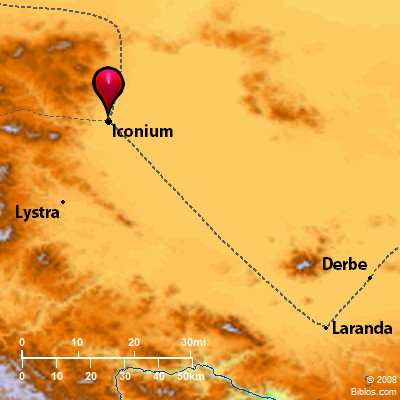Atlas  Iconium and surrounding area
Maps Created using Biblemapper 3.0Additional data from OpenBible.infoOccurrences Acts 13:51 But they shook off the dust of their feet against them, and came to Iconium. Acts 14:1 It happened in Iconium that they entered together into the synagogue of the Jews, and so spoke that a great multitude both of Jews and of Greeks believed. Acts 14:19 But some Jews from Antioch and Iconium came there, and having persuaded the multitudes, they stoned Paul, and dragged him out of the city, supposing that he was dead. Acts 14:21 When they had preached the Good News to that city, and had made many disciples, they returned to Lystra, Iconium, and Antioch, Acts 16:2 The brothers who were at Lystra and Iconium gave a good testimony about him. 2 Timothy 3:11 persecutions, and sufferings: those things that happened to me at Antioch, Iconium, and Lystra. I endured those persecutions. Out of them all the Lord delivered me. Encyclopedia ICONIUMi-ko'-ni-um (Ikonion, also Eikonion, on inscriptions): Iconium was visited by Paul on his first and on his second missionary journey (Acts 13:51; Acts 16:2), and
if the "South Galatian theory" be correct, probably also on his third journey. His sufferings there are referred to in 2 Timothy 3:11.
1. Topographical Position:
The topographical position of Iconium is clearly indicated in Acts, and the evidence of Acts has been confirmed by recent research. Was Iconium in Phrygia or in Lycaonia, and in what sense can it be said to have belonged to one ethnical division or the other? The majority of our ancient authorities (e.g. Cicero, Strabo, Pliny), writing from the point of view of Roman provincial administration, give Iconium to Lycaonia, of which geography makes it the natural capital. But Xenophon, who marched with Cyrus' expedition through Phrygia into Lycaonia, calls Iconium the last city of Phrygia. The writer of Acts 14:6 makes the same statement when he represents Paul and Barnabas as fleeing from Iconium to the cities of Lycaonia-implying that the border of Phrygia and Lycaonia passed between Iconium and Lystra, 18 miles to the South. Other ancient authorities who knew the local conditions well speak of Iconium as Phrygian until far into the Roman imperial period. At the neighboring city of Lystra (Acts 14:11), the natives used the "speech of Lycaonia." Two inscriptions in the Phrygian language found at Iconium in 1910 prove that the Phrygian language was in use there for 2 centuries after Paul's visits, and afford confirmation of the interesting topographical detail in Acts (see Jour. Hell. Stud., 1911, 189).
2. In Apostolic Period:
In the apostolic period, Iconium was one of the chief cities in the southern part of the Roman province Galatia, and it probably belonged to the "Phrygian region" mentioned in Acts 16:6. The emperor Claudius conferred on it the title Claudiconium, which appears on coins of the city and on inscriptions, and was formerly taken as a proof that Claudius raised the city to the rank of a Roman colonia. It was Hadrian who raised the city to colonial rank; this is proved by its new title, Colonia Aelia Hadriana Iconiensium, and by a recently discovered inscription, which belongs to the reign of Hadrian, and which mentions the first duumvir who was appointed in the new colonia. Iconium was still a Hellenic city, but with a strong pro-Roman bias (as proved by its title "Claudian") when Paul visited it.
3. Later History:
About 295 A.D., an enlarged province, Pisidia, was formed, with Antioch as capital, and Iconium as a "sort of secondary metropolis." The Byzantine arrangement, familiar to us in the Notitiae Episcopatuum, under which Iconium was the capital of a province Lycaonia, dates from about 372 A.D. Iconium, the modern Konia, has always been the main trading center of the Lycaonian Plain. Trade attracted Jews to the ancient Phrygio-Hellenic city (Acts 14:1), as it attracts Greeks and Armenians to the modern Turkish town.
4. Thekla:
Paul's experiences at Iconium form part of theme of the semi-historical legend of Thekla, on which see Professor Ramsay's Church in the Roman Empire, 380.
LITERATURE.
Ramsay Historical Commentary on Paul's Epistle to the Galatians, 214; Cities of Paul, 317. To the literature referred to in the notes to the latter book (pp. 448) add Ath. Mitth., 1905, 324; Revue de Philologie, 1912, 48; Journal Hellenic Studies, 1911, 188.
W. M. Calder
ICO'NIUM, a city in Lycaonia, 300 ms. s.e. from Constantinople and about 120 ms. inland from the Mediterranean, now Konieh, pop. about 40,000. There are ruins above the town, and the walls, which are two to three ms. in circumference, are built out of materials of ancient edifices. Strong's Greek G2430: IkonionIconium, a city of Galatia |



